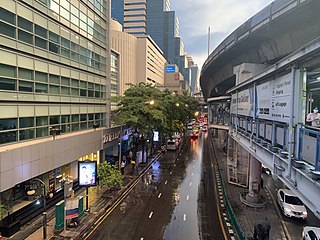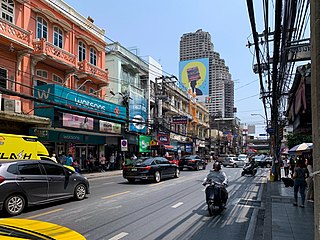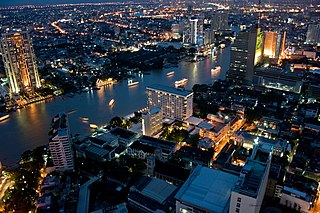
Patpong is an entertainment district in Bangkok's Bang Rak District, Thailand, catering mainly, though not exclusively, to foreign tourists and expatriates. While Patpong is internationally known as a red light district at the heart of Bangkok's sex industry, it is in fact only one of several red-light districts with some catering primarily to Thai men while others, like Patpong, cater primarily to foreigners.

Si Lom Road is a major street in the Thai capital Bangkok, best known for its commercial neighbourhood, which, along with the nearby and roughly parallel Sathon Road, forms one of the city's main business districts. It runs in a southwest–northeast direction between Charoen Krung and Rama IV roads in the city's Bang Rak District, forming the boundary between Suriyawong Subdistrict to its north and Si Lom Subdistrict to its south. Si Lom was one of the earliest modern roads to be built in the city, and some of its side streets serve historic ethnic neighbourhoods from the late nineteenth century, while others are known as shopping and nightlife venues.

Bang Rak is one of the fifty districts (khet) of Bangkok, Thailand. It lies on the eastern bank of the Chao Phraya River, beyond Khlong Phadung Krung Kasem, which marked the old city boundary. Originating from riverside settlements dating from before the city's foundation, Bang Rak grew inland as new roads and canals were constructed through the area during the second half of the nineteenth century and the early twentieth, attracting communities of expatriates and developing into a major commercial district. Bangkok's rapid economic growth in the late twentieth century saw the areas along Si Lom and Sathon roads transformed into one of the city's main business districts, teeming with skyscrapers. The district, officially recognised at least since 1908, covers an area of 5.54 square kilometres (2.14 sq mi), and has a registered population of 48,227. Today, Bang Rak is known for the financial activity of its commercial offices, as well as its vibrant nightlife scenes. Diverse historic and religious sites, most significantly concentrated in Bang Rak Subdistrict on the waterfront, reflect the district's multicultural history.
The Hong Kong Club is a gentlemen's club in Hong Kong, the first in the city. Opened on 26 May 1846, it is a private business and dining club in the heart of Central, Hong Kong. Its members were among the most influential people in the city, including such personalities as senior government officials, senior local businessmen, the heads of the major trading firms, and many legal and accounting professionals. It was often referred to simply as "The Club". The club's first premises were situated on Queen's Road at the junction with D'Aguilar Street.

Sathon or Sathorn is one of the 50 districts (khet) of Bangkok, Thailand. The district is bounded by six other districts : Bang Rak, Pathum Wan, Khlong Toei, Yan Nawa, Bang Kho Laem, and Khlong San.

The Bangkok Christian Hospital is one of the oldest general hospitals in Bangkok, Thailand. Situated on Silom Road, Bang Rak District.

Charoen Krung Road is a major road in Bangkok and the first in Thailand to be built using modern construction methods. Built during 1862–1864 in the reign of King Mongkut, it runs from the old city centre in Rattanakosin Island, passes through Bangkok's Chinatown, continues into Bang Rak district, where it formerly served the community of European expatriates, and ends in Bang Kho Laem. Construction of the road marked a major change in Bangkok's urban development, with the major mode of transport shifting from water to land. Charoen Krung Road was Bangkok's main street up to the early 20th century, but later declined in prominence. It is still home to many historic buildings and neighbourhoods, which are beset by changes as extension of the underground MRT is poised to drive new development.

Bangkok Folk Museum, or Bangkokian Museum, is a museum in Bangkok, Thailand. It is at house number 273 on Soi Charoen Krung 43, near the Sri Rat Expressway, several hundred metres from the left bank of the Chao Phraya River.

Sathon Road is a major road that passes through the districts of Bang Rak and Sathon in central Bangkok, Thailand. It is an important transportation link between Phra Nakhon and Thonburi sides of Bangkok.

The Royal Bangkok Sports Club is an exclusive sports club in Bangkok, Thailand, best known to the public for its horse racing venue. Founded in 1901, it was the first racecourse in the country and one of the oldest golf courses. Originally serving Western expatriates and Thai aristocrats, the club was at the centre of development in the introduction of modern sport to the country during the early 20th century. The club has since maintained its exclusivity, and has a reputation as a domain of high society.

Captain Bush Lane, now officially known as Soi Charoen Krung 30, is a side-street branching off Charoen Krung Road in Bang Rak District of Bangkok, Thailand. It was home to several members of Bangkok's early European expatriate community during the turn of the 19th–20th centuries, including Captain John Bush, an influential English sea captain after whom the street is named.

Si Phraya Road is a road in Bang Rak District, Bangkok, Thailand. It divides the areas of Maha Phruettharam and Si Phraya subdistricts. Built in 1906 by four noblemen of the rank phraya, the road runs from Si Phraya Pier at the mouth of the Phadung Krung Kasem Canal to Sam Yan Intersection, where it meets the Phaya Thai and Rama IV Roads.

The Embassy of the United Kingdom in Bangkok is the chief diplomatic mission of the United Kingdom in Thailand. Established as an embassy in 1947, its history dates to 1856 when a British consul was first posted in Bangkok following the signing of the Bowring Treaty. First established on Charoen Krung Road by the Chao Phraya River, the mission relocated to a new site on the corner of Phloen Chit and Witthayu Roads in 1922. Originally a rural location on the outskirts of the city, the area soon developed into one of the city centre's prime locations. The compound remained a leafy oasis amidst its densely developed surroundings throughout the 20th century, but was sold to Central Group at record-setting prices, first partially in 2007, then completely in 2017. The embassy is now based in an office building on Sathon Road, while its original buildings, including the ambassador's residence, have been demolished to make way for redevelopment.

The Embassy of Portugal in Bangkok is the diplomatic mission of Portugal in Thailand. It is located in Bang Rak District, on the eastern bank of the Chao Phraya River, and is served by Soi Charoen Krung 30. Dating to 1820, with the ambassador's residence built in 1860, it is the oldest diplomatic mission in Thailand, and the ambassador's residence has been recognized as an award-winning historic building.

Surawong Road is a road in the Bang Rak District of Bangkok, Thailand, linking Charoen Krung Road to Rama IV and forming the boundary between Suriyawong and Si Lom subdistricts. It was built at the end of the 19th century during Bangkok's period of expansion following the country's opening up to the West, and was home to many leading businesses, upper-class families, and members of the expatriate community. It was known as a Western-style nightlife entertainment district during the 1920s, and was—and still is—home to many leading hotels. The road grew as a business district along with the nearby Si Lom Road during the mid-20th century, but lagged behind in development toward the end of the century due to its limited traffic capacity. Today, it is still home to several historic landmarks, as well as many well-known restaurants.

Naradhiwas Rajanagarindra Road is a road in central Bangkok. It is a main transport route in the area of Bang Rak, Sathon and Yan Nawa districts. It's an eight-lane reinforced concrete road in the form of boulevard with a width of 60 metres (200 ft), a distance of 5,115 kilometres (3,178 mi). Starting from Surawong road in Suriyawong sub-district, Bang Rak district and heading southeast parallel to Khlong Chong Nonsi, then cut with Si Lom road in the Si Lom sub-district, Bang Rak district, then cut with Sathon road in the area of Sathon district. The road in this portion is a boundary line between Thung Maha Mek and Yan Nawa sub-districts of Sathon district. Therefrom cut with Chan road in the area of Chong Nonsi sub-district, Yan Nawa district and cut with Ratchadaphisek road until end of convergence with Rama III road at Rama III - Naradhiwas junction or Chong Nonsi junction.

Rong Mueang is a khwaeng (subdistrict) of Pathum Wan district, downtown Bangkok.

Bang Rak is a khwaeng (subdistrict) and historic neighbourhood in Bangkok's Bang Rak District. It lies between the Chao Phraya River and Charoen Krung Road, and was home to communities of European expatriates who settled in the area mostly during the second half of the 19th century as Siam opened up to the West. Among them were the Portuguese, French and British, whose embassies occupied extensive grounds in the area, Danes who founded shipping companies as well as the historic Oriental Hotel, and Catholic missionaries who established some of the first schools in the country on the grounds surrounding Assumption Cathedral.

The Neilson Hays Library is a privately funded English-language library in Bangkok, Thailand. It occupies a historic building on Surawong Road in Bangkok's Bang Rak District, designed in neoclassical style by Italian architects Mario Tamagno and Giovanni Ferrero. The library traces its origins to the Bangkok Ladies' Library Association, which was established in 1869, but did not have a permanent location until the current building was commissioned in 1921 by resident American doctor T. Heyward Hays in memory of his late wife, Jennie Neilson Hays, who had been an active member of the library board. The building, completed in 1922, features a symmetrical plan, with a domed rotunda originally serving as the entrance hall, and an H-shaped reading room. The building received the ASA Architectural Conservation Award in 1982, and was registered as an ancient monument in 2001. It underwent major restoration work from 2016 to 2018.

The Embassy of France in Bangkok is the chief diplomatic mission of France in Thailand, and one of the oldest in the country. It was established as a consulate in its current location on the Chao Phraya River off Charoen Krung Road in Bangkok's Bang Rak District in 1857, following the signing of the Treaty of Friendship and Commerce which re-established diplomatic relations between the two countries the previous year. The mission was elevated to a legation in 1892 and an embassy in 1949, and supports the ambassador in promoting political, economic and cultural ties between the two countries.





















